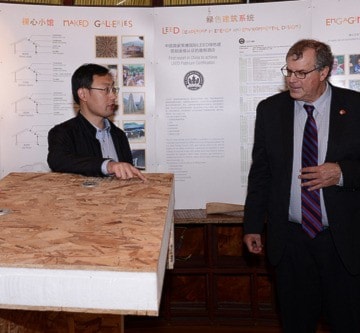B.C.'s annual forest products trade mission to Asia is finding slower growth in the Chinese market, but increasing use of higher-value products such as oriented strandboard.
Forests Minister Steve Thomson and 25 B.C. forest products executives are visiting Shanghai and Beijing this week, after a stop in Japan to meet with government and industry officials. Thomson signed letter of intent with China's Zhejiang province to develop wood frame building, in a rapidly urbanizing country that has traditionally used concrete.
In a phone interview from Shanghai, Thomson said while economic growth in China has slowed, it is still far ahead of North American rates, and Zhejiang province expects a 12.5 per cent increase in wood construction in the coming year.
China still imports mostly lower-grade B.C. lumber to use for concrete forms and interior walls of its sprawling urban apartment blocks, but new construction techniques are catching on. The group toured a resort project using foam-insulated panels made from oriented strandboard and lumber supplied by B.C. producers Ainsworth Lumber, Tolko Industries and Weyerhaueser.
"That's a building system that was pioneered in Canada," said Rick Jeffery, CEO of the Coast Forest Products Association. "Not only were they using our technology, they were using our OSB and our dimension lumber."
Jeffery said Chinese builders and furniture manufacturers are also using more coastal products, including red cedar and higher-grade hemlock.
In Japan, Thomson spoke to an industry conference to assure delegates that B.C.'s pine beetle epidemic has not led to a shortage of high-grade lumber that has been long favoured by Japanese buyers.
Japan has adopted a "wood first" construction policy similar to B.C.'s, which has led to increased wood construction in a country still recovering from the 2011 earthquake and tsunami in the Fukushima region.
Thomson said Japan has 420,000 seniors waiting for spaces in elder care facilities, and wood construction is being offered as a faster and greener way to meet that demand.
He expects B.C. export sales to Japan this year to match or exceed the $700 million total for 2012, and also an increase in the $1.1 billion total sales to China recorded last year.
The Canadian and provincial governments have been financing demonstration wood projects for several years in both countries, sharing the cost with industry to showcase the benefits.
In Japan, the B.C. delegation visited a public market and library built near the Fukushima earthquake zone, and signed an agreement for a third facility for people left disabled by the disaster.



